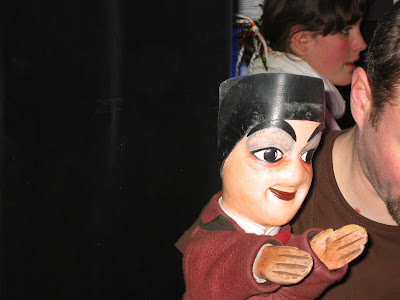 Gône but not forgotten: Guignol, right, on the eve of his bicentenary.
Gône but not forgotten: Guignol, right, on the eve of his bicentenary.(That’s Flageolet the Gendarme beside him.)
Lyon’s most influential son, Guignol, was born in 1808, when an impoverished local, Laurent Mourguet, fell into the line of teeth-pulling. Mourguet noticed that his clients — one wouldn’t call them patients — screamed a lot less volubly when he distracted them by gossiping and telling funny stories. Catching sight of a traveling puppet show, Mourguet had a brainstorm, and he created a hand puppet, giving the clients something to look at, as well as listen to. (We may infer from this that he could pull teeth one-handed.)
Up until that time, puppets observed the conventions of commedia dell’arte, with established character types and nearly immutable plots: Pulchinello became Punch, and occasionally interested himself in politics, but it took Mourguet to revolutionize modern puppetry. His puppet looked like himself — a true Lyonnais from the working class of canuts, or silk weavers — and his routines were improvised, topical and self-expressive. Guignol does adhere to convention with slapstick (he prefers a plain old baton), but more important are the conventions he created.
Mourguet died illiterate, so we have no record of what Guignol said, exactly, until his children took over, during the era of Napoleon III, when censors required every theater to present a written script for approval. To this day, nobody knows for certain where Guignol’s name originated: one theory cites a patois word for “funny.”
His popularity was swift and enduring. Mourguet dropped the teeth-pulling and focused on puppetry; his great-great- great-grandchildren are still at it. For the last hundred years, Guignol has addressed children’s audiences, primarily, but his satirical, adult humor is upheld by Les Guignols de l’Info, a political TV show that closely resembles Britain’s Spitting Image. Itinerant companies crisscross France with Guignol shows. (“Guignol and Nemo” came through Beynes not long ago — and that’s Nemo the Disney fish, not the Verne sea captain.) A scene from an outdoor Guignol show in the Luxembourg Gardens, in Paris, closes every episode of French in Action, an educational TV series in the United States, so that his influence is felt across the Atlantic, too.
Going more or less direct to the source to learn more, I decided to visit one of Lyon’s several Guignol shows, as performed by the Compagnie des Zonzons.
I was the tallest person in the audience, though not the oldest: several grandmothers attended the matinée. The piece was entitled Guignol and the Giant Bonbon, and the target audience was children over five. We were immensely well-behaved, and even the kid who threw up managed to do so tidily, in his mother’s hand. We paid such rapt attention that sometimes we forgot to clap along with the songs and to answer when the puppets addressed us. Apparently, it’s not a Guignol show if at some point one of the characters doesn’t ask, “Which way did s/he go?” and the audience doesn’t scream, "To the left! To the right!”
When, dutifully, we told the candymaker Papillot that the Witch had just made her exit to the left, the old boy mused, “But I don’t understand. The Left doesn’t exist anymore.” A little political humor for the grownups.
 Guignol is big business in Lyon, with several theatres and innumerable souvenirs.
Guignol is big business in Lyon, with several theatres and innumerable souvenirs.This is the shop window of a Guignol “museum” in Vieux Lyon.
For this grownup, the plot was instructive and heartening. A wicked witch was wreaking havoc by jumping into favorite stories. She stole Cinderella’s slipper, so that the Prince couldn’t track her down. She stole Tom Thumb’s pebbles, so that he couldn’t leave a trail to find his way home. Most cunningly, she turned Red Riding Hood’s cloak to blue, so that the Wolf lost his appetite.
”Please, please, Monsieur,” the Grandmother implored, “won’t you devour my granddaughter?”
“Bleagh,” replied the Wolf. “I prefer red meat.”
But Guignol saved the day: armed with a magic pen, he rewrote all the stories correctly. The pen is mightier than the Sorceress. A good lesson for all who write.
There’s a purity to children’s theater, when it’s well done (and this was pretty well done), an economy of means and a simplicity of expression. But it’s got to be sincere, as Joyce DiDonato has explained to me. She sings a lot of Cinderella — the Rossini version — and she’s sung for a lot of school groups, as well. “They can smell inauthenticity a mile away, and call you on it,” she told me. “But I think the other joy for [performing] for young children, is that they haven't yet learned to be inhibited in the theater, and so they feel free to laugh, to scream, to gasp for air.”
Or to run up and down the aisles. But really, we were well-behaved. Honest.
In the dark, I looked around the room to see how the show was playing. I saw plenty of little faces totally transfixed. Their belief in the reality was evident and absolute. Yet the real magic took place when the artifice was stripped away, and we were invited backstage. It’s a remarkably tidy space (albeit too cramped to take good pictures), with dozens of other puppets hanging in carefully organized rows along the walls. Somehow, even when you see the nice lady handling the puppet, and she’s patiently explaining to you how the puppet works, it’s thrilling to see the Witch swooping down on you.
And from the look of it, Guignol is still making friends: and why not? He’s cute, he’s funny, and he’s a gône, a local boy who made good. “I urge you all to keep growing up,” Guignol told us, “so that you can bring your children to see me.” In another hundred years, his next centenary birthday is guaranteed to be a great occasion.

